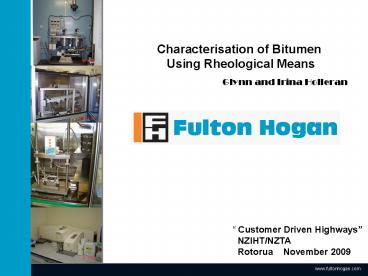Characterisation of Bitumen Using Rheological Means - PowerPoint PPT Presentation
1 / 44
Title: Characterisation of Bitumen Using Rheological Means
1
- Characterisation of Bitumen Using Rheological
Means
Glynn and Irina Holleran
Customer Driven Highways NZIHT/NZTA
Rotorua November 2009
2
Bitumen comes from crude oil
OR OTHER SOURCES
3
Outline
- Specifications
- Bitumen Chemistry
- Rheology
- Bitumen Variability and Measurement
- Modification
- Field Performance
4
"Everything should be made as simple as possible,
but not one bit simpler." Albert Einstein US
(German-born) physicist (1879 - 1955)
5
Specifications
- Bitumen is a moveable feast, it is both shear and
temperature dependant. It will change its
response depending on how its loaded - Traditional specifications measure points and
join them up - PG Specifications measure the physical properties
in the range of interest and correlates them to
field performance
6
Source Exxon-Mobil
7
Types of Performance Specification
- The Bitumen chemistry determines the Structure
and Performance, especially in adhesion and water
resistance - The Bitumen rheology is determined by its
structure and thus chemistry. Structure is
produced by molecular associations, polar type
interactions - Both may be used in specifications and in
deciding what performs best
8
(No Transcript)
9
Polar Molecules have higher Volumes Create more
bulk
10
Bitumen Chemistry
- Complicated! Many sources of crude and blend
materials and different processing
11
Making Bitumen Chemistry Easier to Cope with
- Break it up into bits- fractionation
- Model the bits
- Compare to real life
- Fractionation
- Different methods
- Asphaltenes/Maltenes
- SARA
- SARAB
12
Structure in bitumen is a result of polar
molecular associations
13
Iatroscan FH Method
- This method gives four peaks for the SARA(B)
analysis - Saturates
- Aromatics
- Resins
- Asphaltenes ( Resins B)
14
Reproducibility
15
(No Transcript)
16
Triangular Diagram
0
100
60/70 Light Imports or blends
80/100 Light Imports
80/100,180/200,60/70,40/50 New route Heavy crudes
NZRC
Blown 40/50 NZRC
Resins A
Resins B
Crude/Processing Shift
100
0
100
0
Oils
17
Models Colloidal
- Colloidal
- Microstructural
High Gaestal Index
ARRB
18
Models Microstructural
Colloidally unstable High Gaestal index
AFM Picture
Saudi- Arab Heavy Bitumen 15umX15um
19
Bitumen composition 4 broad chemical types
100000
Adhesion
10000
Flexibility
Molecular weight
1000
Strength
Low Temperature
100
Saturates
Aromatics
Resins
Asphaltenes
20
Example Of Composition Change
21
Compositional Change with Grade
22
Rheology
- Simply how the bitumen reacts to stress and
strain - Characterises real materials parameters compared
to say penetration or softening point
23
DSR
tmax gmax
B
Stress
Time
A
A
A
Strain
C
d
Bitumen in the Middle
Elastic
Viscous
Strain in-phase ? 0o
Strain out-of-phase ? 90o
24
- Unaged and aged samples
- Temp range sub zero to 140C
- Measures a range of rheological parameters
- Prelim work based on AASHTO T315 looking at
premature failures - Very reproducible
25
Repeatability- Control
26
Phase angle shows structure
27
Stiffness at High Temperature shows temperature
and shear susceptibility
28
Stiffness- Intermediate to Normal Temperature
shows likelihood of ravel or stone loss
29
The same effect is repeated for all bitumens e.g.
60/70
30
Stiffness - High Temperature 60/70
31
Stiffness- Intermediate to Normal Temperature
60/70
32
Modified Materials can be characterised e.g. PMB
33
Blending may be done to rheological targets
34
How do we Know it works?- A few Examples
- Round About and Approaches- Heavy Traffic
- Mix design acceptable
- QA on site and in plant acceptable
- Shoved and flushes/Bled in two months
35
Phase angle comparison
36
Stiffness at High Temperatures
37
(No Transcript)
38
Wheel Tracking
39
Heavy Traffic Full Depth Asphalt
- Mix tender and tended to flush
- Hard to compact
- Adjustments improved but did not solve problem
- Bitumen blending to rheologically desirable form
- Problem solved- job met completion date
40
Phase angle comparison
41
(No Transcript)
42
(No Transcript)
43
Other
- Sealing cutbacks stone retention at low
temperatures - Sealing emulsions
- Emulsion stability
- All explained and successfully addressed using
rheological and compositional analysis - A future PG specification is possible for NZ in
both Asphalt and Sealing
44
Conclusions
- This work indicates that bitumen variability is
an issue that needs attention. - The work shows that rheological examination and
compositional analysis can uncover potential
issues not covered in empirical specifications.
The work needs to be extended into very low
temperatures using Bending Beam or Direct Tensile
testing. - Field correlation has been observed and a degree
of predictability. At present this appears to
eliminate the problem materials, but whether this
also eliminates materials that will be acceptable
is not known. - A performance graded specification for all
applications needs to be developed. - The good performance of existing and past NZRC
based materials has illustrated that TNZ M1 is
adequate for this stable supply, but testing has
also shown that variability can create issues.
Import bitumens that meet TNZ M1 may still have
issues and a performance approach can
differentiate between satisfactory materials and
those which may require attention and
modification.































